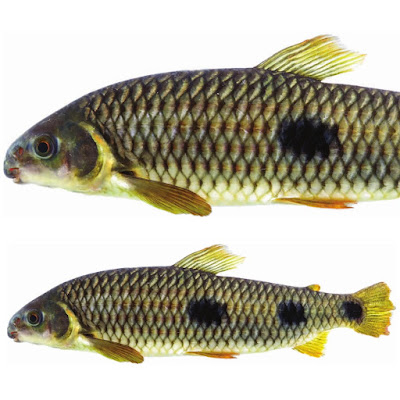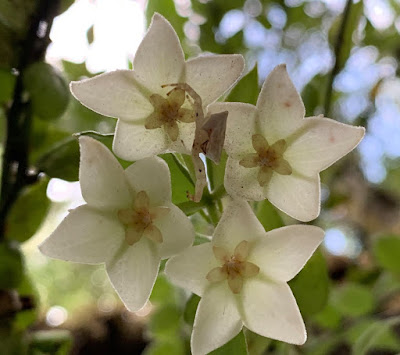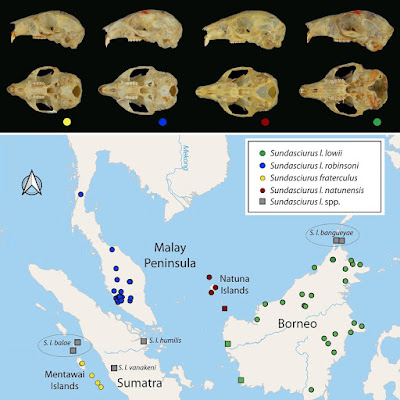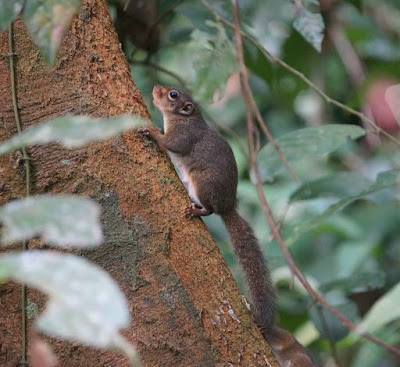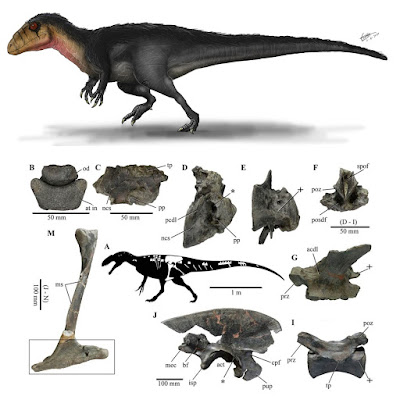[Most Recent Entries] [Calendar View]
Sunday, July 12th, 2020
| Time | Event | ||||
| 7:35a | [Botany • 2020] Oxalis shibeishanensis (Oxalidaceae) • A New Species from Yunnan, Southwest China
Abstract Oxalis shibeishanensis Huan C. Wang & Y. Tian (Oxalidaceae), belonging to O. subsect. Oxalis, is described and illustrated as a new species endemic to Yunnan, Southwest China. It is most similar to O. obtriangulata, but clearly differs from the latter by its 1.5–3 cm long, 3–9 cm wide leaflets with broadly cuneate base and not emarginate apex, 2-flowered inflorescences, narrowly ovate to broadly lanceolate sepals, and the petals being bifid at the apex. Keyword: China, endemism, new species, Oxalidaceae, Oxalis, Oxalis obtriangulata
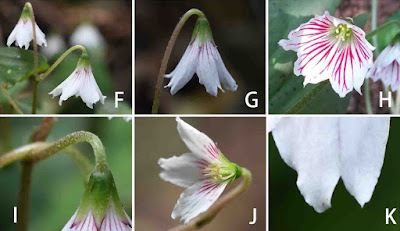  Oxalis shibeishanensis Huan C. Wang & Y. Tian, sp. nov. 石碑山酢漿草 Type: CHINA. Yunnan Province, Shuangbai County, Anlongbao village, Shibeishan Mountain, ..., 24 March 2019, H. C. Wang, F. Yang, Q.P. Wang & Y. R. Li SB5788 (holotype: YUKU [02070800]!, isotypes: YUKU [02070801, 02070802, 02070803]!) Diagnosis: Oxalis shibeishanensis is most similar to O. obtriangulata, but clearly differs from the latter by its 1.5–3 cm long, 3–9 cm wide leaflets with broadly cuneate base and not emarginate apex, 2-flowered inflorescences, narrowly ovate to broadly lanceolate sepals, and petals being bifid at the apex. Distribution and habitat: Oxalis shibeishanensis is known only from two very close localities in Shibeishan Mountain of Shuangbai County, in central Yunnan Province, Southwest China. It usually grows on the moist and shady places near streams or swamps, at altitudes of 1950–2100 m. Etymology: The specific epithet refers to the type locality, the Shibeishan Mountain of Shuangbai County, Southwest China. Ye Tian, Feng Yang, Xiao-Lan Liu and Huan-Chong Wang. 2020. Oxalis shibeishanensis (Oxalidaceae), A New Species from Yunnan, Southwest China. Taiwania. 65(3); 360-363. taiwania.ntu.edu.tw/abstract.php?type=ab | ||||
| 7:50a | [Ichthyology • 2020] Hypomasticus santanai • A New Species of Hypomasticus (Characiformes, Anostomidae) from Eastern Brazil Based on Morphological and Molecular Data
Abstract A new species of Hypomasticus is described from the Rio de Contas, a coastal drainage of eastern Brazil, and its phylogenetic position is proposed based on molecular data. The new species is diagnosed among Anostomidae by possessing a downturned mouth with compressed teeth arranged side by side, 37 or 38 lateral-line scales, three scale series between the dorsal-fin origin and the lateral line and between the lateral line and the pelvic-fin origin, and 12 scale rows around the caudal peduncle. Mitochondrial DNA sequences provide evidence that the new species is closely related to H. mormyrops, H. thayeri, H. copelandii, and H. steindachneri, a clade of species endemic to coastal drainages of eastern Brazil. These results combined with a previous phylogeny support the reallocation of the latter two species from Leporinus to Hypomasticus. The new species is herein considered to be Endangered under the IUCN criteria, due to a small Extent of Occurrence, severely fragmented population, and continued decline of area, extent, and quality of habitat.
Hypomasticus santanai Birindelli and Melo, new species Distribution.— Hypomasticus santanai is only known from the Rio Gongogi and so far endemic to the Rio de Contas basin, a coastal drainage in the eastern portion of the state of Bahia, Brazil (Fig. 3). Etymology.— The new species is named in honor to Edson Santana, a technician at the MZUEL since 1993, for his help in collecting fishes, preparing vertebrate specimens, and maintaining the collections of the MZUEL. His enthusiasm captivated generations of staff and students of the MZUEL. In addition, Edson Santana was in the expedition that resulted in the discovery of H. santanai. José L. O. Birindelli, Bruno F. Melo, Luís R. Ribeiro-Silva, Debora Diniz and Claudio Oliveira. 2020. A New Species of Hypomasticus from Eastern Brazil Based on Morphological and Molecular Data (Characiformes, Anostomidae). Copeia. 108(2); 416-425. DOI: 10.1643/CI-19-335 | ||||
| 8:21a | [Botany • 2020] Hoya longicalyx (Apocynaceae: Asclepiadoideae) • A New Species of Hoya from Yunnan, China
Abstract Hoya longicalyx Wang Hui & E. F. Huang, a new species of Hoya R. Br. (Apocynaceae: Asclepiadoideae) from Yingjiang county (Yunnan, China), is described and fully illustrated. The new species is morphologically similar to H. chinghungensis (Tsiang & P.T. Li) M.G. Gilbert, P.T. Li & W.D. Stevens, but can be easily distinguished by its rounded lamina base, longer and linear calyx lobes, ovate and translucent corona lobes. Result from molecular phylogenetic analysis revealed that the new species was sister to Hoya engleriana Hosseus. Keyword: Hoya, new taxon, Phylogenic Analysis, ITS, 5’- ETS, psbA-trnH, trnT-trnL, matK Hoya longicalyx Wang Hui & E. F. Huang, sp. nov. 長萼球蘭 Type: CHINA. Yunnan Province: Yingjiang county, A-jiang-po, elev. ca. 1900 m, on arboreal branch covered by moss in mid-montane evergreen forest, 16 May 2019, Huang Er-feng 1905003 (holotype SZG!; isotype PE!, KUN!, TAI!). Diagnosis: Morphologically similar to Hoya chinghungensis (Tsiang & P.T. Li) M.G. Gilbert, P.T. Li & W.D. Stevens from which it differs in having longer lamina (1.5–2 cm vs. 1–1.5 cm), acuminate lamina apex (vs. acute to obtuse lamina apex), longer calyx lobes (5– 7 mm vs. 1.5–2 mm), ovate and translucent corona lobes (vs. pink and triangular corona lobes) and oblong and upside apart ovaries (vs. ovate and attached ovaries). Geographical distribution: Hoya longicalyx is known only from the type locality in Yingjiang county, Yunnan province, southwest China, base on the fieldwork and herbaria investigations in HITBC (Herbarium, Xishuangbanna Tropical Botanical Garden, CAS), IBSC (South China Botanical Garden, CAS), PE (Institute of Botany, CAS) and KUN (Herbarium, Kunming Institute of Botany, CAS). Ecology: Epilithic on arboreal branch covered by moss (Trachypodopsis serrulata) under mid-montane evergreen forest. Etymology: Hoya longicalyx is named from its long and linear calyx lobes, which is a significant feature to distinguish the new species from relevant species. Er-Feng Huang, Lei-Lei Yang, Wang Xi, Yi-Ye Liu and Hui Wang. 2020. Hoya longicalyx, A New Species of Hoya (Apocynaceae: Asclepiadoideae) from Yunnan, China. Taiwania. 65(3); 353-359. taiwania.ntu.edu.tw/abstract.php?type=ab | ||||
| 8:33a | [Botany • 2020] Vanilla armoriquensis (Orchidaceae, Vanilloideae) • Living in the Clouds: A New High-elevation Species of Vanilla from Peru
Abstract Vanilla armoriquensis, a new species belonging to subgen. Vanilla, is described and illustrated based on living material from Peru. The new species is similar to V. costaricensis but can be easily distinguished by the larger sepals and petals, and a lip with a well-developed triangular apex, bearing a callus with prominent, broad keels, that has an orange coloration at the base and above the middle. Keywords: Taxonomy; Vanilla costaricensis; V. methonica; V. mexicana; Vanilla subgenus Vanilla; Monocots Alexander Damian and Nicole Mitidieri. 2020. Living in the Clouds: A New High-elevation Species of Vanilla (Orchidaceae, Vanilloideae) from Perú. Phytotaxa. 451(2); 154–160. DOI: 10.11646/phytotaxa.451.2.5 | ||||
| 8:39a | [Mammalogy • 2020] Ancient Divergence Driven by Geographic Isolation and Ecological Adaptation in Forest Dependent Sundaland Tree Squirrels (Genus Sundasciurus)
A surprising amount of hidden phylogenetic diversity exists in the small to medium size, drab colored squirrels of the genus Sundasciurus. This genus is endemic to Sundaland and the Philippines, where it is widespread. An earlier revision of this genus found that the high elevation ‘populations’ of the widespread, lowland slender squirrel (S. tenuis) were different species. Previous phylogenies based on mitochondrial cytochrome b sequences also suggested that the widespread, lowland Low’s squirrel (S. lowii) and the narrow endemic Fraternal squirrel (S. fraterculus) are not reciprocally monophyletic. Additionally, deep divergences have been identified between lineages within Low’s squirrel that date to the early Pliocene. Here we focus on evaluating the relationships and differences within and between populations of these two nominal species using whole mitochondrial genome sequences, nuclear intron sequences, and morphology. We reassess the taxonomy of this group, revalidate the species status of Robinson’s squirrel (Sundasciurus robinsoni Bonhote, 1903) support the species level recognition of the Natuna squirrel (Sundasciurus natunensis Thomas, 1895) and identify three other lineages that require further study. We estimate times of divergence and integrate geologic history to find that most of the divergences are pre-Pleistocene, and thus predate the Pleistocene flooding of Sundaland. Biogeographic, and ecological factors may have played a more important role than climatic factors in generating these patterns. While divergence in allopatry seems to be the main process driving speciation in lowland Sundaland squirrels (Sundasciurus), ecomorphological and behavioral adaptations in this clade suggest an important role of niche divergence. Keywords: Sundasciurus, mammal, Borneo, biogeography, speciation, systematics, rodent, Sciuridae
Sundasciurus robinsoni (Bonhote, 1903) – Robinson’s squirrel Sciurus robinsoni Bonhote (1903):24. —Type locality. Bukit Besar, Nawngchik, Patani, Peninsular Thailand, 2500 ft. Holotype. BMNH 3.2.6.55, skull, skin, adult female, collected 30 August 1901 by C. H. Robinson and N. Annandale Subspecific Taxonomy Sundasciurus robinsoni robinsoni (Bonhote, 1903) Sciurus robinsoni alacris Thomas, 1908e: 306.—Type locality. Selangor-Pahang border, Malaya, 3000ft. Sciurus seimundi Thomas and Wroughton, 1909:440.—Type locality. Kundur Island, Riau Islands Sundasciurus robinsoni balae (Miller, 1903) Sciurus balae Miller, 1903:14.—Type locality. Tana Bala, Batu Islands, Sumatra Sciurus piniensis Miller, 1903:14.—Type locality. Pulo Pinie, Batu Islands, Sumatra Sciurus humilis Miller, 1913:24.—Type locality. Kateman river, East Sumatra Sundasciurus robinsoni vanakeni (Robinson and Kloss, 1916) Sciurus vanakeni Robinson and Kloss, 1916:270.—Type locality. Barong Bharu, Korinchi, Sumatra, 4000 ft. Distribution: Malay Peninsula, Sumatra, and Batu and Rhio Archipelagos. The subspecies S. r. robinsoni and S. r. balae have been recorded from 0–610 m, on the Malay Peninsula and Rhio and Sumatra and Batu, respectively, while S. r. vanakeni has been recorded between 900–1372 m on Mount Kerinci. Sundasciurus natunensis (Thomas, 1895)- Natuna squirrel. Sciurus lowii natunensis Thomas, 1895:26. —Type locality. “Sirhassen Island” (Serasan), Natuna Islands. Holotype. BMNH 94.9.28.40, skull, skin, adult male, collected 23 September 1893 by A. H. Everett. Distribution: Southern Natuna islands (only recorded in Sirhassen Island), and possibly in west Borneo. Despite discrete characters such as postorbital processes and tail shape of the latter populations closely resemble S. natunensis, we currently consider the taxonomic status of west Borneo populations as incertae sedis given the intermediate phenotypic position of these among S. natunensis and S. lowii shown in the PCA and DAPC and the lack of genetic evidence. Genetic data from these, southern Sumatra and northern Natuna populations is needed to clarify the taxonomy and distribution of this group. Sundasciurus lowii (Thomas, 1895) - Low’s squirrel. Sciurus lowii Thomas, 1895: 253. —Type locality. “Lumbidan, on the mainland opposite Labuan”, Sarawak, Borneo. Holotype. BMNH 76. 5. 2. 14., skull, skin, adult male, collected by H. Low (unknown date). Subspecific Taxonomy Sundasciurus lowii lowii (Thomas, 1895) Sundasciurus lowii bangueyae (Thomas, 1908) Sciurus lowii bangueyae Thomas, 1908:387.— Type locality. “Banguey Island” (Banggi) Sundasciurus lowii lingungensis (Miller, 1901) Sciurus lingungensis Miller, 1901:123.—Type locality. Lingung Island, Near Bunguran Island, Natuna Islands Distribution: S. l. lowii is present in Borneo, S. l. bangueyae in Banggi and Balambangan islands, (and possibly Malawali island as well) and S. l. lingungensis in the Northern Natunas (recorded in Bunguran, Lingung and Laut islands). Taxonomic Notes: Corbet and Hill (1992) pointed out that geographical variation in Sundasciurus lowii sensu lato is slight. Many of the currently recognized subspecies are not morphologically distinct from others. We consider Sundasciurus robinsoni balae and Sundasciurus robinsoni vanakeni valid subspecies based on their ventral coloration and craniodental differentiation (Figure 5 and Supplementary Figure S3). We synonymize former Sundasciurus lowii humilis with Sundasciurus robinsoni balae due to external resemblance (ventral grayish coloration in limbs). We also synonymize based on external resemblance (lack of ventral grayish coloration in limbs) Sundasciurus lowii seimundi with Sundasciurus robinsoni robinsoni. Finally, we consider Sundasciurus lowii lingungensis and Sundasciurus lowii bangueyae valid subspecies given their craniodental differentiation (Figure 5 and Supplementary Figure S3). Molecular species delimitation analyses suggest the presence of three species in Borneo within S. lowii (in Sabah, Sarawak and East Kalimantan). However, phenotypic divergence seems to be slight and the fine scale distribution of the morphs is unknown. The only Sarawak sample included in the PCA was clustered separately but close to Sabah + east Kalimantan, that largely overlapped. Regarding the DAPC, only east Kalimantan samples were differentiated from the remaining overlapping populations. Relative size of interorbital breadth seems to differentiate a small number of Sarawak specimens from the remaining S. lowii, but these samples are clustered very close to the other S. lowii. Sarawak specimens also seem to have darker fur than Sabah and East Kalimantan S. lowii and a lack of blond tips on the tail, which are only observed in Sabah populations. We consider these populations unconfirmed candidate species (Padial et al., 2010) until a better molecular and morphological sampling is performed in terms of geographic coverage and number of specimens included. As pointed out by Hawkins et al. (2016a) the two subgenera, Aletesciurus and Sundasciurus, proposed by Moore (1958) are not supported as reciprocally monophyletic groups. The discrete characters (presence of sagittal crest, skull size, and shape of anterior-mesial lobe of auditory bullae) described as distinguishing subgenera were not valid for all species. For instance, the Palawan mountain squirrel (Sundasciurus rabori) belongs to Aletesciurus but lacks a sagittal crest and has an intermediate antero-mesial lobe and skull size (40.9-43.6 mm) among both subgenera (Heaney, 1979; Hawkins et al., 2016a). The northern Palawan tree squirrel (Sundasciurus juvencus) shows an antero-mesial lobe that resembles that of the subgenus Sundasciurus despite being assigned to Aletesciurus. Finally, different species of the subgenus Sundasciurus such as S. lowii, S. tahan or S. altitudinis have skulls that reach sizes (41–43 mm) that overlap with those of S. rabori (authors unpublished data). Although these discrete characters do not support the subgenera Aletesciurus and Sundasciurus, Heaney (1979) found support for them in his morphometric analyses. Molecular phylogenies suggest that there are 5–6 major phylogenetic lineages within Sundasciurus, which correspond to monophyly in the subgenus Aletesciurus (which contains 3 divergent clades), and paraphyly in the subgenus Sundasciurus (which also contains 2–3 divergent clades) (Den Tex et al., 2010; Hawkins et al., 2016a). The lack of universally valid diagnostic features and the phylogenetic evidence from this and previous studies demonstrate that current Sundasciurus subgeneric classification is invalid, so we synonymize Aletesciurus with Sundasciurus. Arlo Hinckley, Melissa T. R. Hawkins, Anang S. Achmadi, Jesús E. Maldonado and Jennifer A. Leonard. 2020. Ancient Divergence Driven by Geographic Isolation and Ecological Adaptation in Forest Dependent Sundaland Tree Squirrels. Front. Ecol. Evol. DOI: 10.3389/fevo.2020.00208 | ||||
| 11:13a | [Paleontology • 2020] Lusovenator santosi • A New Carcharodontosaurian Theropod from the Lusitanian Basin: Evidence of Allosauroid Sympatry in the European Late Jurassic
ABSTRACT Carcharodontosaurian allosauroids were temporally restricted to the Cretaceous, being known from all land masses with the exception of Antarctica. In addition to Veterupristisaurus from Tanzania, exceptions to this distribution have been reported recently, consisting on fragmentary materials from Upper Jurassic strata of China, Germany, and Portugal. Here, we propose a new Late Jurassic carcharodontosaurian taxon, Lusovenator santosi, gen. et sp. nov. based on the reevaluation of previously described specimens from the Lusitanian Basin, Portugal. The performed phylogenetic analysis recovered Lusovenator santosi as an early branching carcharodontosaurian allosauroid diagnosed by an exclusive combination of characters, including three autapomorphic features: (1) large recesses in neural arch of anterior dorsal vertebrae; (2) well-developed and continuous longitudinal laminae extending from the tip of the prezygapophyses to the distal end of the postzygapophyses in mid-caudal vertebrae; and (3) supraacetabular crest of ilium forming a prominent ventrolaterally projecting shelf. Lusovenator santosi is the oldest carcharodontosaurian allosauroid yet discovered from Laurasia and supports unequivocally the hypothesis of a pre-Cretaceous scenario for the radiation of the clade. The identification of this taxon highlights the high diversity of medium- to large-bodied theropods in the later part of the Late Jurassic of the Iberian Peninsula. Carcharodontosauria is not yet known in correlative levels of the North American Morrison Formation, and the existence of contacts after the late Tithonian between these landmasses could explain the distribution of this clade and other dinosaur groups present in the Iberian Jurassic and in the North American Lower Cretaceous. SYSTEMATIC PALEONTOLOGY THEROPODA Marsh, 1881 TETANURAE Gauthier, 1986 AVETHEROPODA Paul, 1988 ALLOSAUROIDEA Marsh, 1878 CARCHARODONTOSAURIA Benson, Carrano, and Brusatte, 2010 LUSOVENATOR SANTOSI, gen. et sp. nov. Etymology— The generic name is composed from the Latin words Luso, referring to Lusitania, the province in Roman Hispania related to the current Portugal, and venator, from the Latin word for hunter; the specific name santosi after José Joaquim dos Santos, who found and collected the holotype. CONCLUSION: A new carcharodontosaurian theropod, Lusovenator santosi, gen. et sp. nov., is defined based on a partial skeleton of a juvenile individual, SHN.036, collected in upper Kimmeridgian levels of the Lusitanian Basin. A second specimen, SHN.019, corresponding to some axial and appendicular elements of a large-sized individual, from upper Tithonian strata in the same geographic area, is tentatively proposed as referred material. Also, an isolated femur previously tentatively assigned to Lourinhanosaurus antunesi is interpreted as belonging to a carcharodontosaur. Thus, the fossil record of these allosauroids in the Lusitanian Basin spans from the Kimmeridgian to the upper Tithonian. Lusovenator santosi represents the oldest member of Carcharodontosauria defined in the Upper Jurassic of Laurasia and extends the record of this clade, which was already represented in the Lower Cretaceous of Europe. Despite the great similarity in the theropod faunal composition, the recognition of a carcharodontosaurian allosauroid taxon provides a component of the Upper Jurassic Lusitanian Basin distinct from its contemporaneous Morrison Formation in North America. The development of a terrestrial dispersal route connecting these landmasses after the late Tithonian could explain the absence of Carcharodontosauria in the diverse theropod faunas of the Morrison Formation and, additionally, their presence during the Early and Late Cretaceous of North America. The new carcharodontosaurian theropod provides the first evidence for sympatry among allosauroid theropods in the Late Jurassic of Europe. Additionally, the discovery of L. santosi sheds light on a poorly known period of carcharodontosaurian history and adds important data to the knowledge of the early evolution of these allosauroids. Elisabete Malafaia, Pedro Mocho, Fernando Escaso and Francisco Ortega. 2020. A New Carcharodontosaurian Theropod from the Lusitanian Basin: Evidence of Allosauroid Sympatry in the European Late Jurassic. Journal of Vertebrate Paleontology. e1768106. DOI: 10.1080/02724634.2020.1768106 |
| << Previous Day |
2020/07/12 [Calendar] |
Next Day >> |








